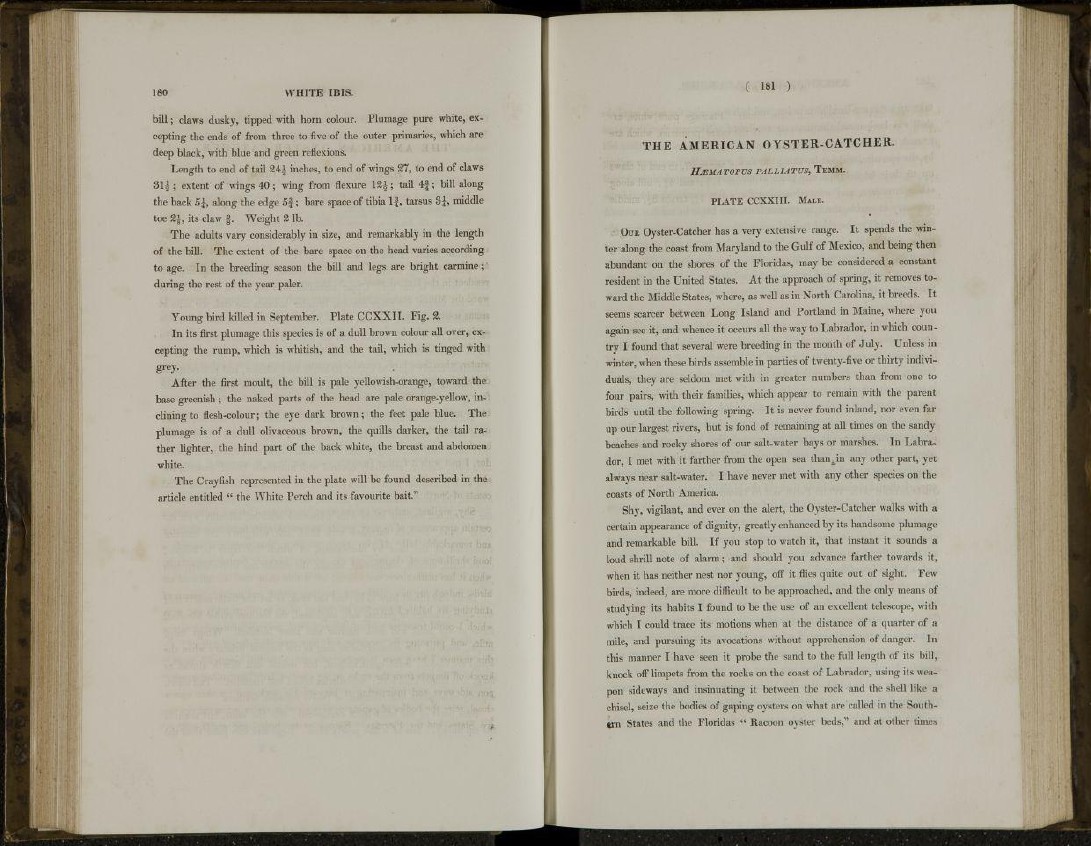
1 8 0 WHITE IBIS.
bill; claws dusky, tipped with horn colour. Plumage pure white, excepting
the ends of from three to five of the outer primaries, which are
deep black, with blue and green reflexions.
Length to end of tail 241 inches, to end of wings 27, to end of claws
31£; extent of wings 40 ; wing from flexure 12|-; tail 4f; bill along
the back 5£, along the edge 5 | ; bare space of tibia If, tarsus 3 | , middle
toe 2 | , its claw f. Weight 2 lb.
The adults vary considerably in size, and remarkably in the length
of the bill. The extent of the bare space on the head varies according
to age. In the breeding season the bill and legs are bright carmine ;
during the rest of the year paler.
Young bird killed in September. Plate CCXXII. Fig. 2.
In its first plumage this species is of a dull brown colour all over, excepting
the rump, which is whitish, and the tail, which is tinged with
grey.
After the first moult, the bill is pale yellowish-orange, toward the
base greenish ; the naked parts of the head are pale orange-yellow, inclining
to flesh-colour; the eye dark brown; the feet pale blue. The
plumage is of a dull olivaceous brown, the quills darker, the tail rather
lighter, the hind part of the back white, the breast and abdomen
white.
The Crayfish represented in the plate will be found described in the
article entitled " the White Perch and its favourite bait.'"
( 181 )
THE AMERICAN OYSTER-CATCHER.
HJEMATOPUS PALLIATUS, TEMM.
P L A T E C C X X I I I . MALE.
OUR Oyster-Catcher has a very extensive range. It spends the winter
along the coast from Maryland to the Gulf of Mexico, and being then
abundant on the shores of the Floridas, may be considered a constant
resident in the United States. At the approach of spring, it removes toward
the Middle States, where, as well as in North Carolina, it breeds. It
seems scarcer between Long Island and Portland in Maine, where you
again see it, and whence it occurs all the way to Labrador, in which country
I found that several were breeding in the month of July. Unless in
winter, when these birds assemble in parties of twenty-five or thirty individuals,
they are seldom met with in greater numbers than from one to
four pairs, with their families, which appear to remain with the parent
birds until the following spring. It is never found inland, nor even far
up our largest rivers, but is fond of remaining at all times on the sandy
beaches and rocky shores of our salt-water bays or marshes. In Labrador,
I met with it farther from the open sea than^in any other part, yet
always near salt-water. I have never met with any other species on the
coasts of North America.
Shy, vigilant, and ever on the alert, the Oyster-Catcher walks with a
certain appearance of dignity, greatly enhanced by its handsome plumage
and remarkable bill. If you stop to watch it, that instant it sounds a
loud shrill note of alarm; and should you advance farther towards it,
when it has neither nest nor young, off it flies quite out of sight. Few
birds, indeed, are more difficult to be approached, and the only means of
studying its habits I found to be the use of an excellent telescope, with
which I could trace its motions when at the distance of a quarter of a
mile, and pursuing its avocations without apprehension of danger. In
this manner I have seen it probe the sand to the full length of its bill,
knock off limpets from the rocks on the coast of Labrador, using its weapon
sideways and insinuating it between the rock and the shell like a
chisel, seize the bodies of gaping oysters on what are called in the Southtin
States and the Floridas " Racoon oyster beds," and at other times